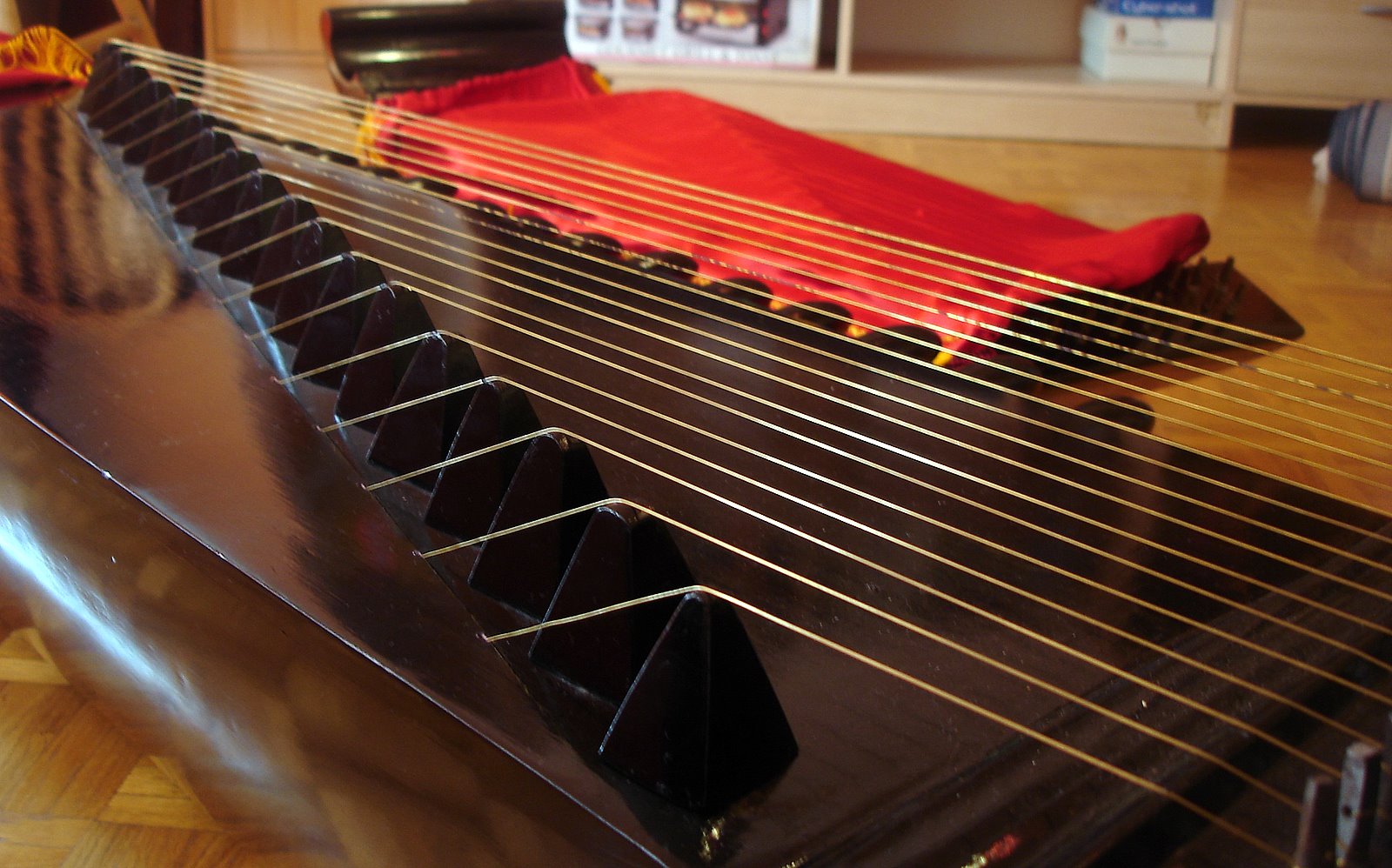|
Tembang Sunda
Tembang sunda, also called seni mamaos cianjuran, is a style of classical vocal music that originated in the Priangan highland of western Java. Unlike Sundanese gamelan music, tembang sunda was developed in the court of the regent Kabupaten Cianjur during the Dutch colonial period (mid-nineteenth century). The traditional vocal portion is sung free verse poetry, the instrumental accompaniment being performed on kacapi (zither), suling (bamboo flute) and sometimes, rebab (violin). A more modern, and metrical, form of lyrics exists that is called panambih. Kacapi suling is played to ornament the vocals, and also at interludes between songs at a typical Tembang Sunda performance. Two kacapis (box zithers), the higher pitched kacapi rincik and the lower pitched , and the suling flute are the instruments used for kacapi suling. Kacapi suling has instrumental pieces performed in two different scales; the first four in laras pelog convey a light mood, the last four in laras sorog ar ... [...More Info...] [...Related Items...] OR: [Wikipedia] [Google] [Baidu] |
Priangan
Parahyangan ( su, ᮕᮛᮠᮡᮀᮠᮔ᮪; Bantenese: Priangan; Dutch: Preanger) is a cultural and mountainous region in West Java province on the Indonesian island of Java. Covering a little less than one sixth of Java, it is the heartland of Sundanese people and their culture. It is bordered to the West by Banten province, to the North by the northern coast region of Subang, Cirebon and Indramayu (former residencies of Batavia and Cheribon), to the east by Central Java province (former residencies of Banyumas and Pekalongan), and to the south by the Indian Ocean. Etymology The name "Parahyangan" has its origins from Sundanese words that mean "the abode of hyangs (gods)". Parahyangan is a mountainous region, and ancient Indonesians believed that the gods resided in the mountain tops. A Sundanese legend of Sangkuriang contains the memory of the prehistoric ancient lake in Bandung basin highland, which suggests that the Sundanese had already inhabited the region sinc ... [...More Info...] [...Related Items...] OR: [Wikipedia] [Google] [Baidu] |
Box Zither
The box zither is a class of stringed instrument in the form of a trapezoid-shaped or rectangular, hollow box. The strings of the box zither are either struck with light hammers or plucked. Among the most popular plucked box zithers are the Arab qānūn and its various derivatives, including the harpsichord (a plucked zither controlled by a keyboard). Historically various people (Lithuanians, Latvians, Livonians, Estonians, Finns, northwest Russians) have played related box-zither type instruments (the so-called Baltic psaltery) in the south east vicinity of the Baltic Sea for centuries. In the United States prominent plucked box zithers include the hammered dulcimer and the autoharp, See also * Zither * Baltic psaltery Baltic psaltery is a family of related plucked box zithers, psalteries, historically found in the southeast vicinity of the Baltic Sea and played by the Baltic people, Baltic Finns, Volga Finns and northwestern Russians. Types Baltic psalt ... Refere ... [...More Info...] [...Related Items...] OR: [Wikipedia] [Google] [Baidu] |
Music Of Indonesia
As it is a country with many different tribes and ethnic groups, the music of Indonesia ( id, Musik Indonesia) itself is also very diverse, coming in hundreds of different forms and styles. Every region have its own culture and art, and as a result traditional music from area to area also uniquely differs from one another. For example, each traditional music are often accompanied by their very own dance and theatre. Contemporary music scene have also been heavily shaped by various foreign influences, such as America, Britain, Japan, Korea, and India. The music of Java, Sumatra, Bali, Flores (Lesser Sunda Islands) and other islands have been well documented and recorded, and further research by Indonesian and international scholars is also ongoing. The music in Indonesia predates historical records, various Native Indonesian tribes often incorporate chants and songs accompanied with musical instruments in their rituals. The contemporary music of Indonesia today is also popula ... [...More Info...] [...Related Items...] OR: [Wikipedia] [Google] [Baidu] |
Sunda Kingdom
The Sunda Kingdom ( su, , Karajaan Sunda, ) was a Sundanese Hindu kingdom located in the western portion of the island of Java from 669 to around 1579, covering the area of present-day Banten, Jakarta, West Java, and the western part of Central Java. The capital of the Sunda Kingdom moved several times during its history, shifting between the Galuh (Kawali) area in the east and Pakuan Pajajaran in the west. The Sunda Kingdom reached its peak during the reign of King Sri Baduga Maharaja, whose reign from 1482 to 1521 is traditionally remembered as an age of peace and prosperity among Sundanese people. According to primary historical records such as the Bujangga Manik manuscript, the eastern border of the kingdom was the Pamali River (Ci Pamali, the present-day Brebes River) and the Serayu River (Ci Sarayu) in Central Java. Most accounts of the Sunda Kingdom come from primary historical records from the 16th century. The kingdom's inhabitants were primarily the eponymous ... [...More Info...] [...Related Items...] OR: [Wikipedia] [Google] [Baidu] |
Pantun Sunda
Pantun Sunda is a type of Sundanese oral narrative performance interspersed with songs and music played on a ''kacapi'', a kind of zither. A pantun is intended to be recited during an evening-length performance during which a single performer relates the story of a hero's initiation: The protagonist leaves his kingdom in order to seek experiences, beautiful princesses to become his wife, power, other kingdoms to subject, the realization of a dream (Rosidi 1984a:143); after having succeeded in reaching his goal he finally returns to his kingdom. Alongside descriptions of historical events, the stories often contain mythical elements. Pantun were originally not written down, the bards often being illiterate and in many cases blind. Originally the performances had a sacred character, as was clear from the offerings made at the beginning of the recitation and also from the content of the introductory part of the story, called rajah, which was an invocatory song, imploring the help of div ... [...More Info...] [...Related Items...] OR: [Wikipedia] [Google] [Baidu] |
West Java
West Java ( id, Jawa Barat, su, ᮏᮝ ᮊᮥᮜᮧᮔ᮪, romanized ''Jawa Kulon'') is a province of Indonesia on the western part of the island of Java, with its provincial capital in Bandung. West Java is bordered by the province of Banten and the country's capital region of Jakarta to the west, the Java Sea to the north, the province of Central Java to the east and the Indian Ocean to the south. With Banten, this province is the native homeland of the Sundanese people, the second-largest ethnic group in Indonesia. West Java was one of the first eight provinces of Indonesia formed following the country's independence proclamation and was later legally re-established on 14 July 1950. In 1966, the city of Jakarta was split off from West Java as a 'special capital region' (), with a status equivalent to that of a province, while in 2000 the western parts of the province were in turn split away to form a separate Banten province. Even following these split-offs, West Java ... [...More Info...] [...Related Items...] OR: [Wikipedia] [Google] [Baidu] |
Suling
The suling or seruling ( Sundanese: ) is a musical instrument of the Sundanese people in western Java, Indonesia. It is used in the Degung ensemble. Bamboo ring flute can also be found in Southeast Asian, especially in Brunei, Indonesia, Malaysia, the Philippines and Singapore. Construction Sulings are made mainly of "tamiang" bamboo (''Schizostachyum blumei'', Nees), a long, thin-walled bamboo tube. The mouthpiece of the suling is circled with a thin band made of rattan near a small hole. Playing method There are two factors that affect a fine suling's tone: #Fingering position. #Speed of the airflow blown by the mouth. The fingering position changes the wavelength of sound resonance inside the suling's body. Depending on the distance of nearest hole to the suling's head, different notes can be produced. The airflow speed also can modify the tone's frequency. A note with twice frequency can be produced mostly by blowing the air into suling's head's hole with twice speed. ... [...More Info...] [...Related Items...] OR: [Wikipedia] [Google] [Baidu] |
Kacapi Rincik
The kacapi ( su, ᮊᮎᮕᮤ) is a traditional zither of Sundanese people in Indonesia. This musical instrument is similiar to Chinese , Japanese ''koto'', the Mongolian , the Korean , the Vietnamese and the Kazakh jetigen. The kacapi played as the main accompanying instrument in the Tembang Sunda or Mamaos Cianjuran, kacapi suling (tembang Sunda without vocal accompaniment) genre (called ''kecapi seruling'' in Indonesian), pantun stories recitation or an additional instrument in Gamelan Degung performance. The word ''kacapi'' in Sundanese also refers to santol tree, from which initially the wood is believed to be used for building the zither instrument. Form According to its form or physical appearance, there are two kinds of kacapis: #Kacapi Parahu (=Boat Kacapi) or Kacapi Gelung; and #Kacapi Siter The Kacapi Parahu is a resonance box with an uncovered underside to allow the sound out. The sides of this kind of kacapi are tapered inward from top to bottom, which gives th ... [...More Info...] [...Related Items...] OR: [Wikipedia] [Google] [Baidu] |
Kacapi
The kacapi ( su, ᮊᮎᮕᮤ) is a traditional zither of Sundanese people in Indonesia. This musical instrument is similiar to Chinese , Japanese ''koto'', the Mongolian , the Korean , the Vietnamese and the Kazakh jetigen. The kacapi played as the main accompanying instrument in the Tembang Sunda or Mamaos Cianjuran, kacapi suling (tembang Sunda without vocal accompaniment) genre (called ''kecapi seruling'' in Indonesian), pantun stories recitation or an additional instrument in Gamelan Degung performance. The word ''kacapi'' in Sundanese also refers to santol tree, from which initially the wood is believed to be used for building the zither instrument. Form According to its form or physical appearance, there are two kinds of kacapis: #Kacapi Parahu (=Boat Kacapi) or Kacapi Gelung; and #Kacapi Siter The Kacapi Parahu is a resonance box with an uncovered underside to allow the sound out. The sides of this kind of kacapi are tapered inward from top to bottom, which gives t ... [...More Info...] [...Related Items...] OR: [Wikipedia] [Google] [Baidu] |
Java
Java (; id, Jawa, ; jv, ꦗꦮ; su, ) is one of the Greater Sunda Islands in Indonesia. It is bordered by the Indian Ocean to the south and the Java Sea to the north. With a population of 151.6 million people, Java is the world's most populous island, home to approximately 56% of the Indonesian population. Indonesia's capital city, Jakarta, is on Java's northwestern coast. Many of the best known events in Indonesian history took place on Java. It was the centre of powerful Hindu-Buddhist empires, the Islamic sultanates, and the core of the colonial Dutch East Indies. Java was also the center of the Indonesian struggle for independence during the 1930s and 1940s. Java dominates Indonesia politically, economically and culturally. Four of Indonesia's eight UNESCO world heritage sites are located in Java: Ujung Kulon National Park, Borobudur Temple, Prambanan Temple, and Sangiran Early Man Site. Formed by volcanic eruptions due to geologic subduction of the Austra ... [...More Info...] [...Related Items...] OR: [Wikipedia] [Google] [Baidu] |

%2C_MfM.Uni-Leipzig.jpg)





